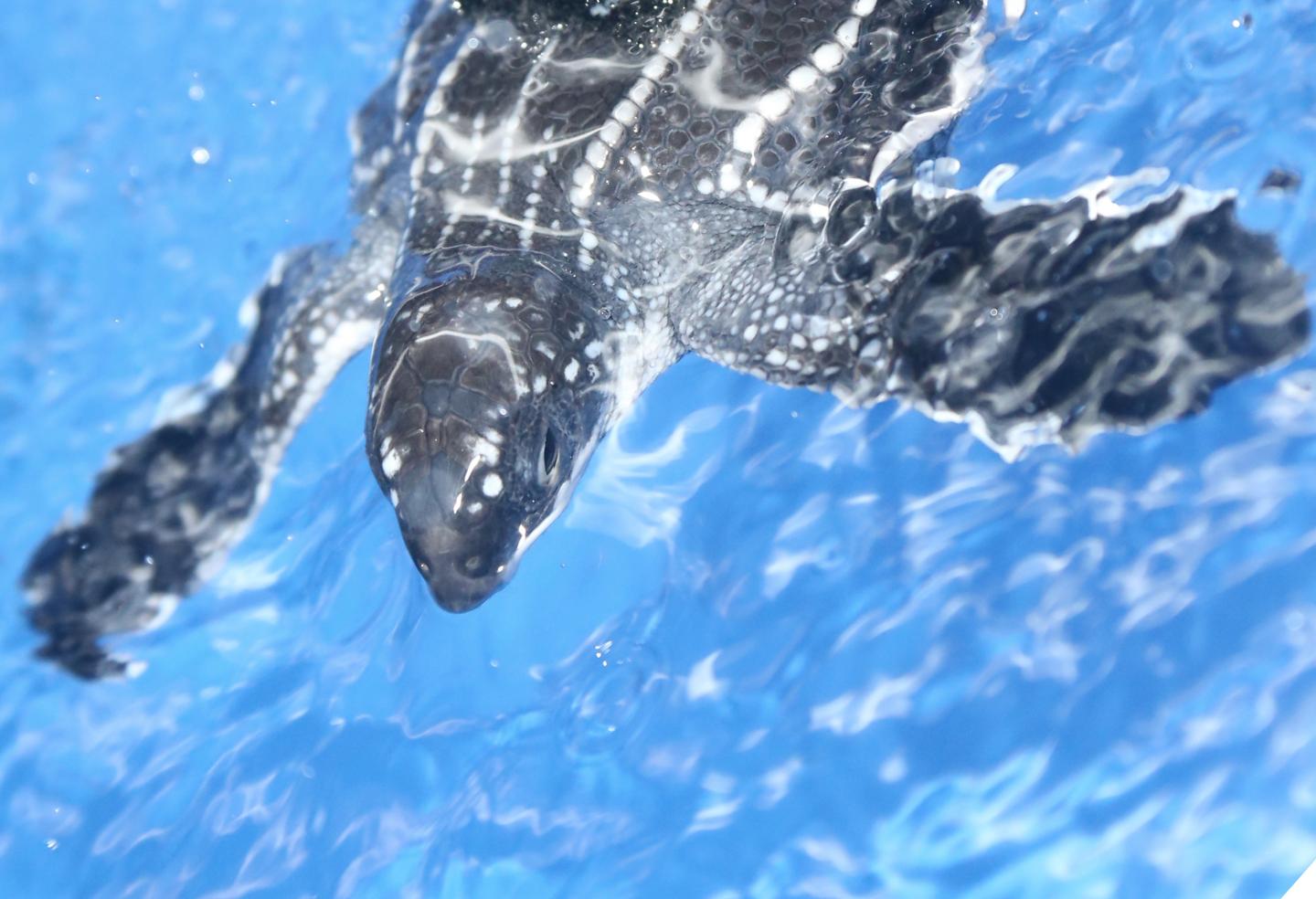
Plump Turtles Swim Better: Insights from Swimming Models

Scientists studied newborn leatherback sea turtles to create the first models of a swimming animal. Challenges to measuring forces like drag and thrust made this difficult before, but the research team overcame these, offering the opportunity for many more to benefit from their findings.
Credit: Photo courtesy of Jeanette Wyneken, Florida Atlantic University
For the first time, researchers at the University of Wisconsin-Madison, Florida Atlantic University (FAU), and the National Oceanic and Atmospheric Administration (NOAA) have measured the forces that act on a swimming animal and the energy the animal must expend to move through the water.
A surprising finding: Longer, slender turtles are less efficient swimmers than more rotund turtles, which get better stroke for their buck.
By taking these measurements, the research team — led by UW-Madison's Warren Porter — built models of swimming turtles and, in doing so, have enabled others to “compute the energetics, behavior and distributions of a species anywhere on Earth now or in the future,” says Porter, a professor of zoology. The findings are published today in the journal PLOS One.
As climate change shifts the habitable ranges of both land and sea animals, and as scientists and others try to reconstruct ancient habitats of long-ago species, the ability to assess and predict an animal's physical interactions with the environment is key. The researchers see their work as instrumental for everyone from land managers to paleoecologists, students and conservationists.
“If you've got mechanistic models, then whatever kind of scenarios you want to run for the environment, you can run these models and have a lot of confidence that they're giving you good numbers,” says Porter, who previously developed a model for land animals.
But getting there wasn't easy.
Several labs have tried to model the movements of animals in water but “swimming animals are very, very difficult to measure experimentally,” Porter says. “It's very difficult to get drag and thrust.”
No one before had been able to measure the fluid dynamics of a swimming creature, or the energetics required to perform the work of moving through water. This allows scientists to measure critical aspects of biology, such as how much food an animal must eat to survive.
It was serendipity that connected Porter and the lead author of the study, Peter Dudley, a former graduate student in Porter's lab, to the scientists at FAU who would eventually help solve the problem.
Jeanette Wyneken, FAU professor of biological sciences, had developed methods to keep newborn leatherback sea turtles in the lab for study. She and her former students created a tether system that allows the turtles to swim freely while also staying safe; the turtles don't recognize barriers and can easily injure themselves in their enclosures.
Porter, Dudley and Todd Jones — Wyneken's former graduate student and now a NOAA physiologist — tethered the turtles to instruments that allowed them to measure the force they produced while swimming. They also measured the oxygen the turtles consumed (a direct measure of their metabolism) and the heat they exchanged with the environment. All the while, the scientists took video of the tiny turtles.
Then the team recreated a virtual environment with a swimming turtle, to see if they could predict how much energy the turtle was using. Dudley, whose background is in engineering, says Porter uses “on-the-ground” engineering tools in his lab.
They scaled this up to model the three-dimensional motion of swimming juvenile leatherback sea turtles , to find power and heat transfer rates during the larger animal's flipper strokes.
It was here, by playing with the parameters of their virtual reality turtles, that the researchers learned husky turtles were better swimmers than their leaner counterparts.
“That was a surprise and I thought it was a mistake when I originally did it,” says Dudley, who eventually learned that the flippers of thinner turtles come closer together at the bottom of their stroke than those of larger turtles, causing them to lose power.
It is that question — how does body size interact with the physical environment to constrain evolutionary design — that lies at the crux of the study's findings.
“We can literally design animals now and ask how are they going to function, just like a car or a rocket ship,” says Porter. He is currently engaged in a UW-Madison initiative called Climate Quest, a competition to solve climate-change problems, and is putting this expertise to use.
In his project, he is assessing the impact of climate change on milk production in dairy cows in order to “select for cows 50 or 100 years from now,” to improve production both now and in the face of a different planet.
“Now that we have (models) for both marine and terrestrial environments, we can answer those types of questions and get back to the big mass extinctions and get some insights into how did animals live before and after those extinctions,” Porter says. “Why were the animals that survived able to survive?”
The researchers collaborated with Riccardo Bonazza, a UW-Madison professor of engineering physics, to develop their swimming turtle models. And it was the art department, says Porter, that enabled them to create a virtual swimming turtle.
“When you're looking at a problem, the more different ways you can look at it, the more different perspectives you can get on it, the more ideas you can have on how to deal with it and … on different directions you can go,” says Porter.
The study was funded in part by the UW Foundation and a Disney Worldwide Conservation Fund grant.
CONTACT: Warren Porter, 608-262-1719, wpporter@wisc.edu; Peter Dudley, P.N.D.PhD@gmail.com












